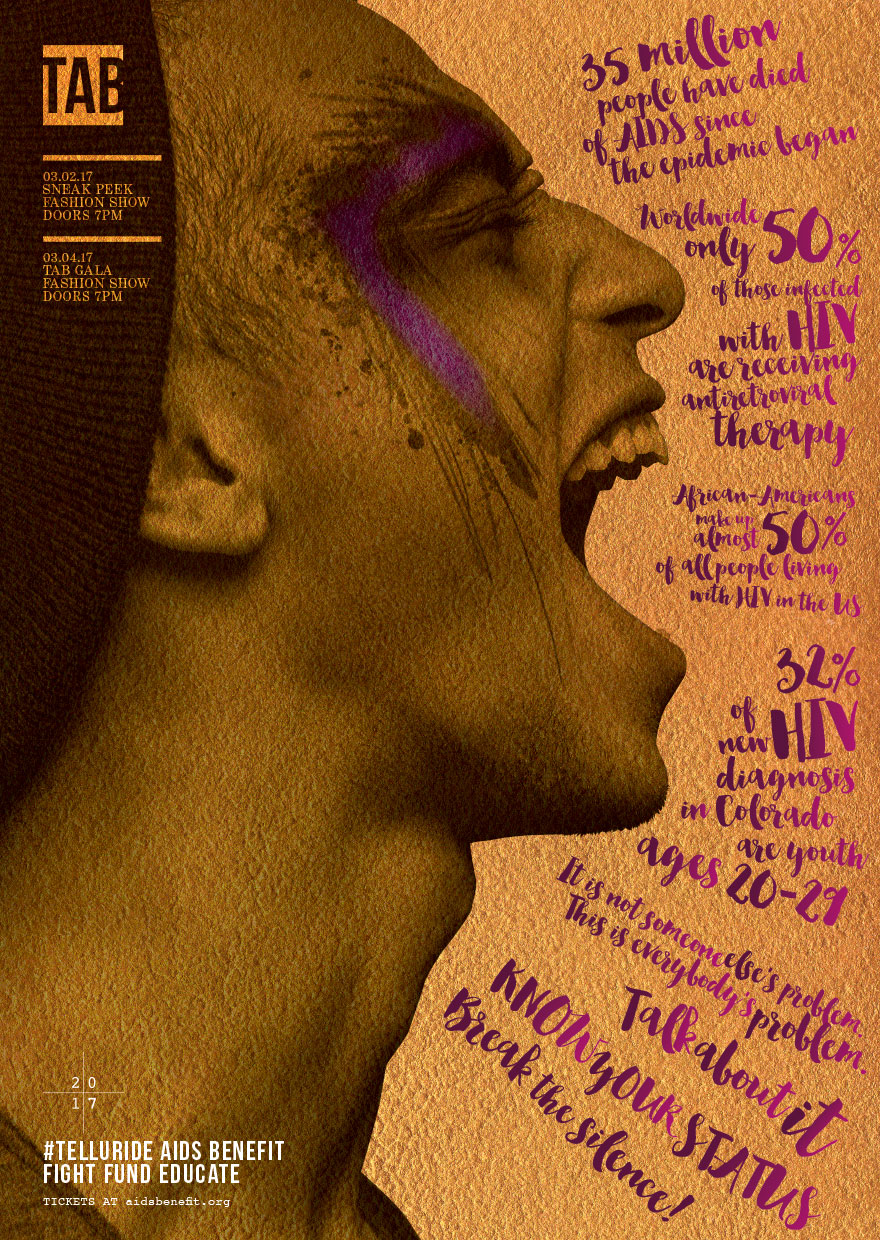
20 Feb Telluride AIDS Benefit: 2017 Overview
The Telluride AIDS Benefit continues to wave its “Fight.Fund.Educate” banner on high – and with good reason. With regard to HIV/AIDS prevention and treatment, today’s political environment is, at best, a giant question mark; at worst, toxic. On the scientific front there may be cause for optimism, but to date there is still no definitive cure.
TAB’s week of awareness education and fundraising to help support hundreds of individuals and families of all demographics living with HIV/AIDS begins February 23 with the Student Fashion Show. It ends with sample sale on Monday, March 6, following the Gala Fashion Show & Auction on March 4 at the Telluride Conference Center in Mountain Village. New this year, on March 3, a special edition of Twenty(by)Telluride, a joint venture between Telluride Arts and TAB.
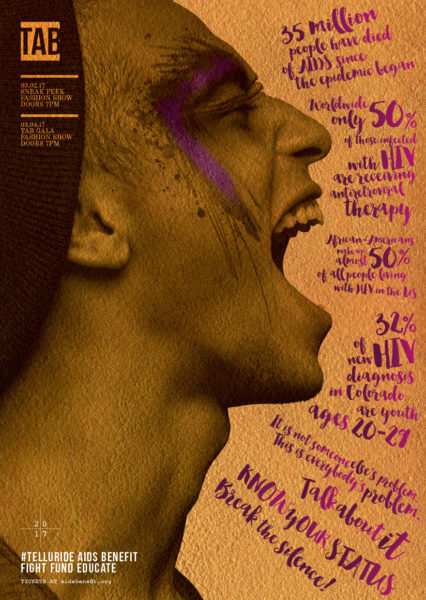
HIV/AIDS: The Big Picture
The forecast: Sunny – or at least sunnier – though dark clouds still loom on the horizon.
According to a recent article in hivplus.mag., “Thanks to prevention strategies like PrEP, the rates of new HIV transmission have seen a tremendous decline. But there is still work to be done.”
“Maximizing the power of these new prevention tools in conjunction with testing and education efforts, offers the hope of ending the HIV epidemic in this nation,” Dr. Eugene McCray, director of CDC’s Division of HIV/AIDS Prevention, said in a statement. “Science has shown us the power of HIV treatment medicines in benefitting people with and without HIV.”
Then there is the case of Timothy Ray Brown.
According to fredhutch.org, “A decade has passed since the first of two stem cell transplants cured Brown of both leukemia and HIV, making him the first and so far only person to be cured of the virus that causes AIDS.”
“I think that you all agree with me that Timothy’s case, as a proof of principle, has changed a lot of the field of HIV research,” said Dr. Gero Hütter, the German doctor who cured the the man. “Timothy is the motivation for hundreds of researchers, fundraisers, and activists to go forward to the big target that HIV/AIDS can be cured.”
From itechpost.com:
“Just as HIV patients lose hope in finding the right cure for the disease, here is yet another groundbreaking discovery that sheds light to the ongoing problem. A team of researchers led by experts from London’s University College has recently found that despite the presence of a protective protein, the team was able to identify how HIV is able to infect macrophages, which is known to be a type of white blood cell integral to the immune system. Because of this, experts consider the study to have brought the international scientific community one step closer toward finding a cure for HIV and AIDS… Meanwhile, as per International Business Times, as the researchers began with their study, it was found that the discovery could lead to researchers using inhibitors in healthy human bodies. In return, experts believe that the process will ultimately prevent white blood cells from turning off their antiviral proteins and effectively eradicating any chance for HIV to spread throughout the body…”
Very hopeful, but does the research mean we should recycle our red ribbons?
Is the age of AIDS finally over?
The once buzzy disease rarely if ever makes national headlines. We saw no red ribbons attached to the fabulous gowns and tuxes at this year’s Golden Globes or SAG Awards. Once trendy, AIDS Rides have been run off the road for years now. And World AIDS Day? That tends to pass with a yawn. Yet after about 34 years since “the virus” was first announced in France, there is still no silver bullet: a vaccine to thwart HIV remains a Holy Grail.
What’s more, the virus still has a foothold in more than 150 countries on six continents and infection rate in the U.S. alone over the past 10 years remains largely unchanged, about 56,000 new incidents per year. Currently, worldwide there are 39 million people living with HIV/AIDS, 1.2 million people in this country alone. Almost 1 in 7 (14%) are unaware of their infection. Closer to home, about 12,000 people are known to be living with HIV/AIDS in Colorado. Worse, one in five people living with HIV/AIDS in our state is unaware of his/her status and over 32% of new HIV diagnoses are youths, ages 20 -29.
With Washington in the picture, TAB is arguably more relevant than ever in 2017.
“…The Trump presidency is providing an unnerving picture for the future of AIDS-related issues. Under the Affordable Care Act, Medicaid was greatly expanded and many prerequisites were dropped to make access to care easier for almost 45% of HIV positive people. Many of these improvements are likely to be cut or trimmed in the new administration. This will make other funding such as that provided by the Telluride AIDS Benefit more relevant than ever…,” explains TAB’s website.
For more on HIV/AIDS in the Trump era, read what TAB’s managing director Sarah Gluckstern has to say.
The Telluride AIDS Benefit, with its aim of “Fight, Fund, Educate” has long operated ahead of the curve and very successfully on behalf of a growing list of beneficiaries.
A Brief History of TAB, The Little Engine that Could:
With a swiftness that imitates the spread of the disease itself, AIDS became enmeshed in the fabric of our society. As people watched friends and family members cut down in the prime of their lives, many tried to make sense of the scourge by channeling their pain into ways to help. A small group of locals led by Kandee DeGraw founded the Telluride AIDS Benefit in 1993 because they wanted to help a friend defray his costly medical expenses.
That friend was Robert Presley, a one-of-a-kind, a kooky creative genius and local enfant terrible. Fabrics were his canvas. He dyed, slashed and frayed them into submission, turning improbable materials into provocative designs. Robert died from complications due to HIV/AIDS in August 1997, having walked the runway only months earlier at TAB’s fabulous fashion show decked out in lime green and wearing a sash that read “Miss AIDs.”

Ron Gilmer with Robert Presley back when.
In its first year, the nascent non-profit netted about $12,000. At Robert’s request, the money went directly to the Western Colorado AIDS Project (WestCAP), a community-based referral and educational providers which assists HIV-infected individuals and families across 25 counties in Western Colorado.
Now in its 24th year, TAB has a disbursed well over 2$2 million– $1 million to WestCAP alone – to caregivers and educators from the Western Slope and Front Range in Colorado all the way to Africa.
WestCAP remains TAB’s primary beneficiary. Another at the top of a short list is the Children’s Hospital HIV Program (CHIP) in Denver, a clinic within a hospital dedicated to providing children with the HIV infection with family-centered, state-of-the art care. (Denver is one of the Top 10 children’s hospitals in the country.)
But the list of beneficiaries has swelled to include the Ethiopian Family Fund, Manzini Youth Care, Generation Ubuntu, Brother Jeff’s Community Health Initiative, and the University of Colorado Hospital Fund.
How has TAB managed to keep on keeping on despite economic swings that have challenged other nonprofits over the years?
In part the answer is Telluride: we are a tiny community with a big (bleeding) heart.
The rest of the answer is top down effectiveness and efficiency.
TAB has had a succession of inspired and inspiring leaders starting with its Grand Potentate (or Grand Vizier as he is also known), Ron Gilmer, Robert Presley’s former partner.
Kandee, was TAB’s first executive director. She was followed by other super capable and motivated individuals including Greg Craig and Ellen Geldbaugh, who worked as a team, Amy Kimberly, Betsy Adler, Lynne Domingos, Stash Wislocki, and now Michelle Maugham.
Educator Sandy McLaughlin has spearheaded TAB’s education initiatives in Telluride’s schools since the 1990s.
Baerbel Hacke. director, Telluride Gallery of Fine Art, has tirelessly put together TAB’s art auction since 1998. She retired this year but was still consulted on the art being featured on Friday night.
Where Your TAB $$$$ Go: The Beneficiaries:
TAB on the Front Range & Western Slope:
Note: 85% of TAB funds are used in the state of Colorado for client care, education, and HIV prevention.
Western Colorado AIDS Project:
In 1994, when TAB was just a year old, WestCAP was still a very small nonprofit operating out of Grand Junction under the direction of a small board of directors and administered part-time by a nurse, Shelley Nielsen. Nielsen did great work with the Mesa County Health Department and as part-time executive director/case manager for WestCAP. Clients being served lived primarily in Mesa County, until Presley worked his magic.
Thanks to Presley and TAB, WestCAP was able to grow into a much larger, private non-profit providing resources, referral, case management, financial assistance, and support to people living with HIV/AIDS and their families in 22 counties on the Western Slope.
The biggest bonus of the money donated by the Telluride AIDS Benefit continues to be the fact that the monies it gives are discretionary.
AIDS prevention efforts remain the primary initiatives funded by TAB’s annual gift to WestCAP.
WestCAP also uses a considerable chunk of the money to assist with nutritional support; to contract with bi-lingual Spanish speakers to do outreach work in the Hispanic community; and to translate documents into Spanish for monolingual clients.
TAB money helps pay for supplement care for purchasing medications that are not on the ADAP (AIDS Drug Assistance Program) formulary; paying insurance premiums; and covering high co-pays for HIV medications.
WestCAP also uses TAB funds to provide client assistance with clothing, vitamins, utilities, transportation to medical care, participation in the client retreats, training for staff to enable them to deliver services appropriately, and to purchase computer equipment.
WestCAP recognizes the fact that many donors may not like the thought of their money paying salaries, but if there is no one to decide how the money is spent, write the checks, and tend to the budget, the organization would cease to exist. Federal funding sources tend to be restrictive and cover little or none of the administrative costs.
Children’s Hospital Immunodeficiency Program (CHIP):
CHIP began providing specialized care for HIV+ children in the Rocky Mountain region in 1991. CHIP remains the only entity in the region providing comprehensive, coordinated, family-centered services to infants, children, youth (13-24), pregnant women, and parents of HIV-infected children.
As a National Institutes of Health-funded Pediatric AIDS Clinical Trials Group (PACTG) site, CHIP has participated in national and local research trials for pediatric HIV infection since 1992 and now ranks among the top performers in the network. As a model program, CHIP frequently welcomes visiting professionals from agencies and other institutions around the world.
CHIP’s staff includes highly-trained, committed professionals with years of experience in delivering high-quality HIV care and prevention, more than half of whom have been providing HIV care for over 10 years. Medical providers include physicians certified in pediatric and internal medicine, infectious diseases, adolescent and pediatric general medicine, obstetrics/gynecology and nurse practitioners with expertise in family practice, pediatrics, and midwifery. CHIP has several licensed clinical social workers with particular expertise in serving at-risk youth, families, and pregnant women.
Annually CHIP families gather for CHIP Art Day, one of several get-togethers the nonprofit puts together to promote bonding in a safe, relaxed environment. At Art Day, participants work to create art for the Telluride AIDS Benefit’s annual auction. Expressing themselves enhances self esteem.
Brother Jeff’s Community Health Initiative:
In 2000, Brother Jeff began his fight to combat the effects of HIV/AIDS in his community.
“Everyone saw the destructive impact youth violence was having on African Americans. However, few noticed the impact of HIV disease. This silent killer was ravishing African Americans.”
According to the Centers for Disease Control, the HIV/AIDS epidemic in African American communities remains a public health crisis. While African Americans represent approximately 12 percent of the U.S. population, they continue to account for a higher proportion of cases at all stages of HIV/AIDS—from infection with HIV to death with AIDS.
Statistics from 2012 suggest that nearly half of the 1.1 million people living with HIV infection in this country are African American. African American women represent roughly 60% of all new cases of HIV in women. In the United States more than half a million have died of AIDS, to date, and well over 195,000 of the deceased are African American.
Brother Jeff’s Community Health Initiative (BJCHI) is a leading resource in dealing with African American HIV cases in Colorado, and throughout the U.S. The nonprofit has even made inroads on the African continent. None of this would have been possible without a partnership with the Telluride AIDS Benefit and the Telluride community.
TAB funding has allowed Brother Jeff to hire HIV-positive individuals as speakers, peer role models, and outreach workers. In a community where stigma, distrust, fear, and alienation are common, these courageous individuals bridge the gaps among isolation, care, and acceptance.
African American faith institutions play a vital role in the perception and dissemination of information. TAB funding has also helped develop HIV ministries and interfaith collaborations. Numerous churches and faith institutions call on Brother Jeff to speak with their congregations and assist them in developing programs. Throughout the process, myths such as the common notion that HIV can be spread through baptismal waters are dispelled.
BJCHI reaches thousands of people each year through HIV conferences, summits, workshops, presentations at high schools, universities, and at various health-related institutions.
HIV prevention is vital. However, funding for HIV prevention is limited. TAB funds allow BJCHI the flexibility to distribute prevention messages and materials in a way that reaches the community. The Initiative is also able to provide temporary housing, transportation, food, financial assistance, counseling, testing and referrals at its discretion. Through TAB funding BJCHI has the ability to use its knowledge of the African American community to meet needs immediately.
Brother Jeff has worked with Ron Gilmer, Presley’s former partner, as a committee member on the governor-appointed Colorado Advisory Council on AIDS, reinforcing the link between TAB and the African American community.
University of Colorado Hospital Fund:
The University of Colorado Hospital Fund is the nonprofit that holds monies on behalf of the Specialty Care Clinic of Grand Junction, which serves patients living with HIV/AIDS in 22 counties in western Colorado.
The need for the clinic was identified in 1998, but the care center launched in January 2000 with a grant received from Ryan White Part C.
The clinic embodies the mission statements of St. Mary’s Hospital and the University of Colorado Health Sciences Center to provide access and high-quality care to its patient base, which includes the poor and vulnerable, through collaboration with HIV experts from the leading state academic hospital in Denver.
“Since 2000, our client base has tripled,” said Kristy Watkins, RN MPH, program coordinator, St. Mary’s Collaborative Care Clinic.
“TAB approached us two years ago as a community partner working with WestCAP to serve patients in rural western Colorado,” continued Watkins. “We now use TAB funds to help clients pay for medical bills not covered by Ryan White monies. TAB dollars also assist clients with transportation to get to medical appointments and in getting rapid HIV test kits, which are not covered by grants. Because they can get to appointments and pay their medical bills, our patient retention rate is higher, resulting in optimal health outcomes. TAB funds also allow the clinic to test and diagnose early. Early treatment often prevents the virus from becoming full-blown AIDS and spreading. TAB funds make it possible to hold quarterly clinics in the Durango area and assist clients living there as well. In general, people with HIV/AIDS who are in clinic care such as ours, live longer, healthier lives.”
About Kristy Watkins:
Kristy Watkins is registered nurse with a masters of public health degree and a background in, and passion for public health. Prior to joining the clinic, Watkins spent six years at the Mesa County Health Department in immunizations and family planning. For the past two -and-a-half years, she has been with Western Colorado Specialty Care Clinic and for the past year plus has worked as program coordinator, a job that includes quality assurance for the program, data collection, grant-writing, and reporting.
TAB in Africa:
The world continually shrinks through telecommunications, and tragedies and countries become communities like Telluride with different constituencies, but similar challenges. AIDS is one problem we all share.
Yes, still.
The Telluride AIDS Benefit is a model nonprofit: the organization asks for very little in monetary support from the greater Telluride region, but puts Telluride on the world map in a good way: TAB’s welcomed embrace extends all the way to Africa.
TAB’s African outreach began in 1999, when the nonprofit teamed up with the African Mayors Initiative for Community Action on AIDS at the Local Level (AMICAALL) and the United Nations Development Program in a pilot project utilizing a “sister city” approach to combating overwhelming odds.
“Ubuntu” is a name based on an African philosophy all about the connection among all human beings. “I am because we are” is a phrase commonly associated with the belief. Ubuntu is based on mutual support and sharing what you can to help others. The following description is attributed to Nelson Mandela.
“Ubuntu [is] that profound African sense that we are only human through the humanity of other human beings.”
Ubuntu Africa’s mission flows organically from that idea. The organization is dedicated to improving the health and well-being of HIV-positive children in under-served communities by establishing community-based programs that provide lifesaving health and support services. Ubuntu Africa is also committed to fostering an empowered attitude towards HIV/AIDS among young people worldwide and engaging them to participate in improving conditions for people affected by global health challenges.
Founded by a remarkable young lady named Whitney Johnson, Generation Ubuntu provides services in Khayelitsha, the second largest township in South Africa, home to an estimated 1 million people. In addition to having high rates of HIV, the Khayelitsha community also faces high levels of poverty, unemployment, and crime. Many HIV-positive people in the community lack easy access to clinics, nutritious food, antiretroviral drugs (ARVs), and indoor plumbing, making their illness particularly difficult to manage.
Before Generation Ubuntu there were few support services offered to children in Khayelitsha living with HIV. After being diagnosed with the virus, young people in Khayelitsha were often left to bear the burden of the disease completely alone.
Realizing her vision, Johnson established Ubuntu Africa, now Generation Ubuntu, with the help of a friend, Doni Belau, 10 years ago when she was 22 and a recent college graduate.
AIDS may be the worst health calamity since the Black Death of the Middle Ages, certainly one of the worst pandemics ever. And, according to online research, 10 of the 11 infections that take place every minute around the globe occur in Sub-Saharan Africa, where in some countries teachers, doctors and nurses are dying faster than they can be replaced and treatment ranges from poor to nonexistent.
The Manzini Youth Project was started as a community service initiative by the boys of the Salesian Secondary School in Manzini, in response to the growing numbers of street children in Swaziland. Children were taken off the street and housed in the disused mortuary rooms of St Teresa’s mission, with the primary intention of re-integrating them into their families. With the Salesian community of Don Bosco in Manzini, Father Larry McDonnell assembled a local community committee to establish the shelter.
Now, the Manzini Youth Care Project provides accommodation, food, shelter, education, training, and life skills to marginalized, orphaned, abandoned and homeless young people at risk through poverty.
Swaziland is a difficult place with an unsupportive monarchy and MYC relies on the generosity of individuals and outside funds.
Ethiopia is the fourth poorest nation in the world. However, unlike many African countries, Ethiopians, who divide among Muslim, Jewish and Orthodox Christian, peacefully co-exist. Given the rampant poverty and wholesale lack of education, HIV risk is high and medications are very limited. According to UN estimates, about 3 million Ethiopians have been exposed to the AIDS virus, with over 600,000 children made orphans and one-third of Ethiopia’s hospital beds used by carriers of the disease.
In the West, AIDS may be ubiquitous, but it is also manageable. In the developing world, however, the AIDS crisis remains muzzled and the disease regarded as something mysterious, a stigma or punishment for some unnamed and unnameable wrongdoing. Though campaigns in Africa have been implemented, their effect has been token. New medicines that have been effective in the West for containing HIV are very costly and virtually unavailable to African AIDS patients. In Ethiopia, much like in Manzini and the rest of Africa, people are fighting what appears to be a losing battle against the epidemic.
Inspired by Telluride Mountainfilm regular Dr. Rick Hodes, his sister-in-law Marla became executive director of the Ethiopian Family Fund (EFF) after a visit to the country in 2006.
EFF remains committed to improving the lives of Ethiopians through educational opportunities and access to healthcare, while respecting their cultural integrity. The nonprofit has cultivated close relationships with friends and businesses in Africa, which allows it to honor and respect Ethiopia’s rich culture and local knowledge, and adapt to the needs of the people it serves.
Schedule of Events, Notes from the TAB Team:
For a full schedule of events, go here.
The 2017 Student Fashion Show will be held on Thursday, February 23, 6 – 7:30 p.m. at The Palm.
This is year #16 of the TAB Student Fashion Show, originally started in 2001 by former TAB director Amy Kimberly and Sandy Mclaughlin.
McLaughlin is a retired educator from the Telluride School District and a current TAB board member/educational liaison. She has remained the show’s producer, aided (for the pasrt six years) by Telluride High School teacher Jessica Heady, who helps ensure the operation runs smoothly. And that’s no small feat, considering this year’s “cast” includes 50 models, plus directors and choreographers and three crew members.
Co-directors this year are seniors Emma Spaulding and Brianna Brown. Co-choreographers are seniors Hadley Murphy and Mary Lynch. The student intern is Joey Hunt. The lighting director is Connor Hazen, with spotlight assistance from Simon Perkovich. Jerrica Steger is stage manager.
“The Telluride AIDS Benefit Student Fashion Show started a number of years after TAB was founded. Local high school students saw the opportunity to educate their peers about a global issue and they seized it. The first TAB Student Show was in 2001 – and here we are in 2017, ready to perform our 16th show. This year, we are dispelling the stigma surrounding AIDS and HIV at the ‘Masquerade.’ The show goes up on Thursday, February 23, 6 p.m., at the Palm Theater. We hope to see everyone there to ‘take the mask off AIDS.’ Tickets are available online at www.aidsbenefit.org, and in the Palm lobby the day of the show, from 10 a.m. until show time. Tickets are $20 for adults and $10 for school staff and students. Please come out and support our students!,” said Spaulding.
In addition to the Student Fashion Show, there will be educational programs in Telluride and Ridgway:
“On Thursday, March 2, I am also going to Ridgway MS/HS with Jessica Heady and Whitney Johnson, our Generation UBUNTU beneficiary, along with some of our HS students, to present an AIDS education program,” said McLaughlin.
For more on TAB’s education programs, go here.
A brand new event, Twenty(By)Telluride: The HIV Edition, takes place Friday, March 3, 6:30 – 8:30 p.m. at Telluride’s Sheridan Opera House. The event is free to the public and the Opera House SHOW Bar will be open for libations.
“Why a change to Friday night programming? After 21 years orchestrating TAB’s Friday art auction, Baerbel Hacke thought the benefit should mix it up a bit,” explained Daiva Chesonis. “When the board and TAB’s executive director brainstormed about a new event, the idea of a Twenty(by)Telluride—an initiative of Telluride Arts—came up. This special HIV Edition features five presenters. The popular silent auction of artwork by kids and parents of CHIP is still happening, and free food will be served, all donated this year by La Marmotte, Pescado, Oak, The Cosmo, Butcher and Baker, and 221. In addition, 10-12 art pieces which Baerbel helped us select are available for sale through a silent auction, with prices ranging from $500-$2,500. Personally, I’m thrilled to be the MC for the event, circling back into the TAB family as a newish member of the board.”

Signed Neil Young guitar, one of many unique items at TAB 2017 auction.
To support the beneficiaries, TAB hosts an auction after the Sneak Peek Fashion Show on Thursday, March 2, with the big push happening after the Gala on March 4. Go here for a preview of some of the unique items and packages, including a guitar sign by Neil Young, an Everest Trek, tickets to New York Fashion Week, plus rare wines and spirits.


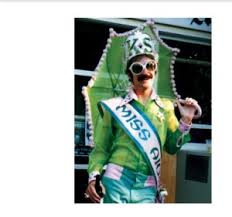
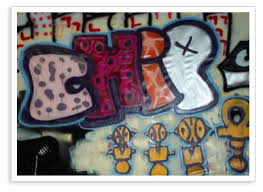

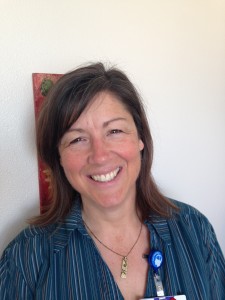

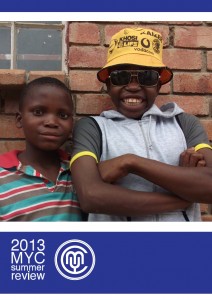

Sorry, the comment form is closed at this time.